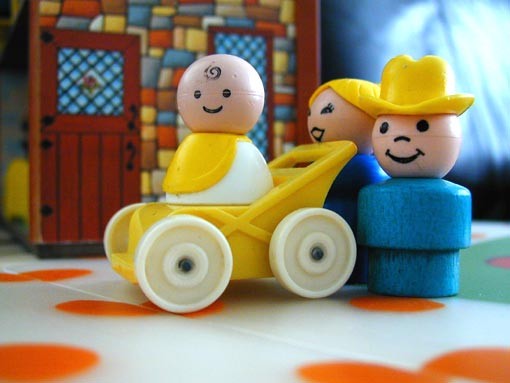The classic family with father, mother and child is still the ideal of many, but the reality is different. Single mothers, single fathers or patchwork families are not yet the rule, but they are no longer the exception. The value of the family has changed in the past 100 years. At the University of Mainz, sociologists have been studying the value of the family in Germany in the 20th century for a year.
By Christoph Gehring

Ideal type one "right" Family. (Stock.XCHNG / Marek Wojtal)
"What is generally heard is that one speaks of the death of the family or of the end of the middle-class nuclear family, or that one complains about the signs of decay. This is now not a phenomenon that can only be found in the Federal Republic, but has already appeared again and again in the very modern era. And then the question is, how do you deal with it, what has society done with it, what is the interplay between values, institutions and social practice."
Christopher Neumaier is a research assistant at the University of Mainz and he speaks these big questions relatively calmly: How have social norms of value changed, how have they changed in the last century and what do norms of value, if they change, do with society and its smallest value-bound ones Unity, the family?
These are questions for which the German Research Foundation has provided more than 190,000 euros. The DFG is using the money to finance the research project of Christopher Neumaier’s boss, the Mainz professor of modern history, Andreas Rödder. Some time ago he wrote a book about the Federal Republic in the 1970s and 1980s and found that there is something like a blank spot in the scientific examination of values and changes in values in society, an academic terra incognita – the period between the First World War and the 1960s, when sociology suddenly and unexpectedly believed that there was a profound change in values in modern western society. But: where did he come from, this change in values that was so unequivocally reflected in the statistics of social researchers? Good question, says Andreas Rödder.
"The social scientists have been talking about the big cut since the 1960s, but because they work with survey data and always only look at their own present – which is also their interest in finding out – they cannot therefore make any really valid statements at the time before they do so Surveys – that is, since the 1960s – have been able to collect. That means the social scientists speak of the secular change of values, but cannot really cover the diachronic dimension. Historians have recognized that this change in values is an important phenomenon, but they have never examined this change in values from a historical-diachronic perspective. This is most likely to have made the middle class the researchers who examined bourgeois values in the 19th century, but this research largely ends with the First World War. And now, on top of that, what the social scientists identify as an area of change in values largely corresponds to what bourgeois values of the 19th century are, but there is a huge gap between the First World War and the social science research that then began since the sixties. So the question of whether it is really such a big break, the question of how it changes in the long term and why values change, that is the question of the project."
So was that what led from bold post-war Germany to the wild seventies, to the good-looking eighties, the hedonistic nineties and the apparently everything and everyone tolerant early 21st century – was it all the result of a social tectonic eruption sometime in the sixties? Or was it really a slow process in the course of which the German bourgeoisie adapted its traditional values to newer insights into the world, existence and men and women? Christopher Neumaier on the socially recognized family values of the young Federal Republic, as set out in the legislation.
"When the Federal Republic was founded, the patriarchal structure was upheld in the discourse and also by political decision-makers. Therefore, this patriarchal family structure was initially consolidated. And another scientist, Till van Rahden, then examined how paternal authority changed in the 1950s and how that was broken down in principle in the 1959 judgment of the Federal Court of Justice. And this is exactly where we want to start. We take action on the Till van Rahden’s research results and examine how paternal authority has changed and what can be determined in more detail in conclusions about the changes in values in the 1950s."
It should first be noted that one of the irrefutable values in the 1950s was still: men and women are not the same. At that time it was even in the law, Clause 1360 BGB. It said that "the wife fulfills her obligation to contribute to the maintenance of the family through work, usually by running the household" fill, "the husband [against] through employment". Housewife marriage as a legal norm. Later in the Civil Code, paragraphs 1628 and 1629, it even said that the father had the last word on parenting issues regarding education and that only the father was the legal representative of a minor child.
It took the judgment of the Federal Constitutional Court of July 29, 1959 to at least make it clear that the so-called "paternal casting vote" in education questions according to paragraph 1628 is wrong, because the relationships of both parents to the child "the same in essence". It was something like a change of values by court order.
The historian Till van Rahden just mentioned by Christian Neumaier has in a rather readable essay the reaction of the then influential weekly newspaper "Rhenish Mercury" on this first judicial step towards equality between men and women.
The "Rhenish Mercury" Foamed: Instead of the family as "The nucleus of all earthly communities" to protect, the judges would have used an argumentation that the spirit "dusty scuffles from the suffragette era" breathe. And further:
"Thanks to this adherence to the principles, we are now faced with a break in the most unsuitable authority, namely the state, into the area whose internal order and health make up the good state as an association of as many good families as possible. It is easy to imagine how happily one will rub one’s hands over this formal democratic leveling of the family in the Soviet zone. In order to limit the damage, the Bundestag should once again take up the question of how the state can protect marriage and family in their existing cultural tradition."
Those were the days. Times when equality between women and men in raising children was understood as an attack on the values of the middle-class family. Andreas Rödder:
"As far as the fifties are concerned, one must of course take into account: it is the decade after the war. So it is the decade of a society that yearned for nothing more than a certain calm and stabilization, a society that had experienced war, breakdowns, shortages, catastrophes for over thirty years. The fact that this society longed for peace and order in the 1950s, that is, an intact world of the family was constructed in an environment, in a historical context, where the families were not at all well through the war, that explains , I believe, also a lot with regard to the fifties, which from a retrospective perspective often appear to us to be so calm, so quietistic, so leaden and musty. But if you take a closer look, there is hardly a time when families were as fragmented as at that time, due to the war, the loss of an entire generation of soldiers, death-related, disabled, warrior widows and so on. Families were rarely torn apart as in the years after the Second World War, for which we speak of the heyday of the middle-class family."
The middle-class family, as people have known it for 130 or a few more years, is traditionally a construct of mother, father, offspring – and feeling. Not necessarily the feeling of exuberant love between the spouses, but the feeling of agreement in basic norms of value and security against the rigors of life outside, the world of work.
"From the start, the modern, middle-class family has been something of an alternative to modernity in the area of the business world, in the area of the world of work. While in the area of the modern working world of the citizen, the male citizen, who does his business, has to be professionally flexible and mobile, had to act quite rationally – Max Weber found market relationships as an element of modern rationality – while in the area of The world of work, the male-dominated world of work, where flexibility and rationality and mobility prevailed, the family was opposed to it, especially since the middle-class family, all female, was the place of emotionality, an emotionality that had never been so binding for families in this form. the place of emotionality and stability. This tension between family and the world of work was created in the 19th century and it is of course a tension that continues to this day despite postmodernity, despite the most modern family policy and cannot be resolved. And this tension between the family and the world of work is a continuum that runs through the modern age and, in principle, has not touched anything of the changes that took place in the 1960s,"
Andreas Rödder believes. There they are again, the sixties of the last century, which sociology sees as the turning point in society, the phase of rapid, if not abrupt, revaluation of all values.
Andreas Rödder and his team are quite convinced that their research project on changing values in family and society can bring a new perspective on the suddenness of the changes. In any case, Andreas Rödder’s second scientific project member Jörg Neuheiser says:
"I believe that these, yes, these striking breaks in the 1960s disappear when you look at the historical perspective. That you cannot say that there is such an obvious, dramatic change due to a new image of women, for example, around 1960, but that one has to speak of a shift in a continuum of opposing values, which then became relevant in the 1960s are."
Of course, a conceptual clarification is also undoubtedly relevant: What are the bourgeois values whose change the Mainz historians want to examine? Andreas Rödder explains:
"First of all, there is a work ethic and willingness to perform, b.) The idea of personal responsibility and independence, c.) High culture and education, it is d.) The area of the family and e.) A religiously based social morality. These are the categories that can be called civil values in the broader sense and which we then apply in the narrower sense to our project."
A key concept around which the change in values, as far as it has been investigated and diagnosed to date, is that "freedom", So the detachment from social constraints and conventions, the meaning of which has been lost over the course of a hundred years: the job is no longer necessarily the center of self-definition; Children go through without any curtsey or servants to greet their aunt as well-brought up; it can also be a decent citizen who does not go to church regularly; the tie is not a Need more so that a man is dressed correctly; if women love women or men love men, that’s the way it is and no longer a crime; and in the bourgeois family of modern times, the distribution of roles is discussed in long discussions at the kitchen table. And when the similarities are exhausted, you separate, because everyone has the freedom to terminate a social relationship – even if they do "marriage" is called. On behalf of Andreas Rödder, the young historian Christopher Neumaier from Mainz also explores the question of researching changes in values:
"What role does the middle-class nuclear family still play today? There are single mothers, there are single fathers, there are couples who live together without marriage certificates. It is precisely this plurality of family forms that will be the main focus that we will turn to in the last third of the 20th century. In principle, the replacement of the middle-class nuclear family by a plurality of family forms."
Andreas Rödder believes, however, that there are also dark sides to the freedom of plurality of all possible forms of life. Dark sides of today that result from historical yesterday and the change in values in between:
"The greater freedom of choice is both an opportunity and an imposition. The number of those who can no longer cope with their children has increased in the sign of this increased freedom. The parents may not have been more competent parents in the past than today, but there was a clearer framework, clearer guidelines on how to do things. Whether that was right or wrong, but it gave you certain certainty to do so. If you just go to any station bookstore and take a look at the educational guides, then the pedagogical staff testifies to the great helplessness that went with postmodern freedom. Likewise, however, there are those who know how to use this freedom all the more in the sign of the increased freedom. Politics, of course – and this is a completely bipartisan phenomenon – in my opinion, very strongly, too strongly, depends on the problem groups and, in the opinion of equal opportunities, I now want to bring the whole society under a new, conforming scheme , Again, I think this is a problematic pattern compared to the growing plurality."
A pattern that historians at Mainz University will examine. Just like the many other patterns of change in values and their effects. For three years they have time and money from the DFG. In the end, Andreas Rödder hopes to be able to explain better together with his scientific staff.
". how value change processes have taken place, whether there are major breaks and how things have developed in the long term. That is the first. The second is that we hope to recognize in much more detail how the interplay of values, the interplay of everyday social behavior at the social level and the interplay of, third, with social and legal structures. Do the values change first and then the behavior? Or does the behavior change and then the values and then the legal regulations? Things play together, but we would like to know more exactly how this works. And then we would see processes of change in values in the present that actually always attack us and that we then find to be so, then we would be able to assess them much more precisely, as we hope."
RELATED ITEMS
-

When the mother withholds the child from the father – baby and family
Mothers who do not allow paternal engagement act like security guards in front of the child. Scientists call this behavior maternal gatekeeping. It…
-

7 Common mistakes in parenting – I’m a mother
Most parents are probably wondering whether they are doing everything right when raising children. It is important to recognize mistakes in the upbringing,…
-

Or father-child cures A mother-child cure, or father-child cure, is not to be confused with a pure child cure. Not the child becomes alone…
-

Family policy – it started at 25 dm per child (archive)
Child benefit was introduced 50 years ago. Stefan Sell in conversation with Katrin Heise. The social scientist Stefan Sell reminds that this…
